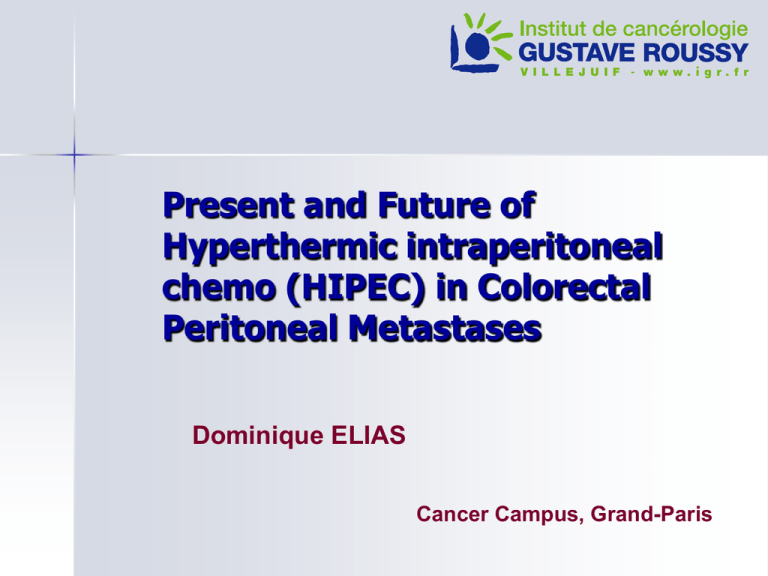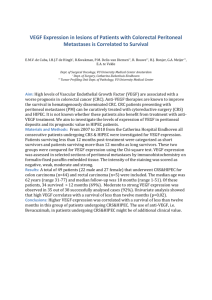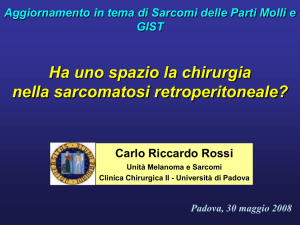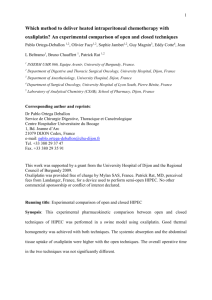
Present and Future of
Hyperthermic intraperitoneal
chemo (HIPEC) in Colorectal
Peritoneal Metastases
Dominique ELIAS
Cancer Campus, Grand-Paris
Stages IV treated with Chemo: PC have a
poorer prognosis than other sites
From the phase III trials N9741 and N9841 (Folfox / Folfiri)
Without PC
Nb
Median OS
1731
17.6 months
p< 0.01
With PC
Conclusion:
364
12.7 months
- Shorter OS and DFS when PC
- 5-y survival with Folfox (all pts: 4%)
(Franko J et al. ASCO 2011)
Is it possible to obtain definitive
cure with CCRS + HIPEC ?
(Goéré et al. Ann Surg 2013, on line)
•Prospective study of our patients treated between January 1995
and December 2005 (n=93).
•Learning curve = worst results.
The Cure = no recurrence during a minimal
delay of 5 years
Median follow-up: 99 months
Median Survival : 34 months
Overall 5-year survival : 32%
1.00
0.90
0.80
0.70
0.60
0.50
0.40
0.30
0.20
0.10
0.00
Overall Survival
Disease-free
Survival
0
Absolute cure at 5
years:17/107 pts = 16%
12 24 36 48 60 72 84 96 108 120
Months
At risk
93
93
89
49
64
24
41
16
33
16
27
14
15
10
8
7
5
4
2
3
1
2
At 10 years:
102/612 pts =16,7%
At 5 years without rec.
24/148 pts =16%
At last……
1)
Hepatectomy for PM or HIPEC for PM:
overall survival and definitive cure rates are
the same.
2)
Peritoneum can be considered as an
organ, a site of metastasis, similarly to the
liver .
Current survival rate of 146 colorectal PC
treated with CCRS + HIPEC:
Prospective bi-centric study (Paris/ Montpellier)
Median survival:
41 months
5-year
survival:
48%
(Quenet, Elias et al, Ann Surg 2011; 254: 294-301)
Is there a benefit to use
surgery alone ?
Surgery versus No Surgery
Is there a trial comparing ?
Surgery
Similar patients
®
No Surgery
Answer is: NO
Complete resection alone of PC ?
Nb
Mulsow 2011
Selection
Median OS
5-Y Survival
31
IP <10
25 months
22%
57
+ SPIC*
25 months
18%
30
IP <10
30 months
25%
(Erlangen)
Cashin 2012
(Uppsala)
Evrard 2012
(Bordeaux)
*SPIC = Sequential postop. intraperitoneal chemo.
Retrospective comparative study
In the control group: 3.4 lines of chemo
Median survivals: 25 months vs 60 months
C H IP
D ifférence entre les
m oyennes de surv ie
restreinte
C him io
(Elias et al. J Clin Oncol 2009; 27:681-5)
Conclusion:
No clear difference between resection and no
resection.
When it is possible to easily resect the PC: probably
it is useful for the patient.
If you do it, median survival will be at least 25-30
months.
Who is it interesting to
resect, and how to resect ?
French registry: 523 colorectal PC treated with
cytoreductive surgery + intraperitoneal chemo
treated in 23 centres.
Multicentric retrospective study (15 years),
Including the leaning curves of all the centres = the
worst results
Complete cytoreductive surgery (CC0) in 85% of the
cases
Postoperative deaths: 3%
Morbidity (grade 3-4): 30%
Mean hospital staying: 22,5 days
(Elias et al. J Clin Oncol 2009; 27: 681-685)
Overall Survival of the 523 patients
Median survival: 30 months
5-years survival: 27%
Survival according to the Radicality
of the Surgery (p< 0.0001)
Look at the median survivals….
The Peritoneal carcinomatosis
Index (PCI)
(Ranging from 1 to 39)
Survival according to the Extent of the
Péritoneal Carcinomatosis (p< 0.0001)
PC with associated LM ?
IGR’series:
61 HIPEC alone vs 37 HIPEC + LM
(Maggiori L et al. Ann Surg 2013)
Retrospective study issued from a prospective data
base.
Selection of similar patients (61 and 37):
Age, Sex, Status of the primary, PCI (mean was 13),
radicality, systemic chemotherapy.
Except for LM
Mortality: 4%; Morbidity: 54%
Higher Survival rate (p=0.04) when
no LM
Overall Survivals according to the
extent of the disease
PCI<12 without LM : 76 months
PCI<12 + LM <3:
40 months
PCI≥12 or LM ≥3: 27 months
What patients to resect ?
Those with a PCI < 20
Those with a good general status
LM are not a contraindication if resectable
without major risk
Is it useful to add HIPEC ?
Principle of HIPEC:
A combined treatment
1.
2.
Surgery to treat the visible disease (> 1 mm)
HIPEC to treat the remaining non visible disease.
The strong belief of surgeons in the efficacy of
this « package » encourages them to devote a lot
of time and a lot of energy to resect all visible
disease (+++).
Impact of HIPEC alone:
experimental data
60 rats with colorectal PC were randomized in 3 arms.
Hipec: 90 min, close procedure, inflow temperature at 42°C.
CRS
Nb
R2
Med. Surv
P
20
6
43d
CRS + HIPEC
Mito 15 mg/m²
20
4
75d
0.003
CRS + HIPEC
Mito 35 mg/m²
20
4
97d
< 0.001
Conclusion: Efficacy of HIPEC and efficacy of increasing dosage.
(Klaver Y et al. Br J Surg 2010; 97: 1874-80)
Complete surgery (CS) alone
versus CS plus HIPEC ?
We have not yet the answer
French Prodige 7 trial is on going
Complete cytoreductive surgery
®
HIPEC
Oxali, 30 min, 43°C
+5-FU and Leuco IV
No HIPEC
Already 250 randomized patients among the 280…
Equivalence between LM
and PM
287 hepatectomy
119 CCRS+HIPEC
Exclusion of [Hepatec + CCRS-HIPEC] (n=37)
Subgroups according to the global tumor load:
– LM in 2 groups: ≤ 10 LM, and > 10 LM
– PM in 3 groups: PCI 1-5, 6-15, > 15
Same overall global
survival
Overall survival for the 2
gps of LM
Overall Survival for the 3
gps of PM
Equivalence of prognosis
between LM and PM
Application and extension of this therapeutical
concept:
Introduction to the concept of a SecondLook Surgery in patients at high risk of
developing colorectal peritoneal metas. at
the moment of the resection of the primary
(Elias et al. Ann Surg 2008; 247: 445-450)
Rational of the second-look
HIPEC is all the more « light » and all the more
efficient that the PC is minimal. But to detect early
minimal PC is possible neither with clinic neither with imaging.
It is the reason why it is logical to propose a
systematic second-look to asymptomatic patients
presenting high risks to develop a PC, with the aim
to treat PC at an early stage.
Definition of High-risk patients
(Honoré C. et al. Ann Surg Oncol 2013; 20: 183)
Review of the literature
(6522 articles)
No real high-risk:
–
–
–
–
–
–
–
Occlusive tumors
Bleeding tumors
T4
Positive cytology
Positive lymph nodes
Rignet-cell tumors
Mucinous tumors
Risk ≤ 20%
Real high-risk:
- Perforated tumors
- Peritoneal metastases
- Ovarian metastases
Risk between 35% and 80%
Patients et Methods
Patients with a high risk to develop a PC: we selected 3 gps:
– With minimal macroscopic PC (which was completely resected during
surgery)
– With ovarian metastases
– With perforation of their primary tumour
All these patients received the adjuvant standard treatment after the
first surgery: 6 months of systemic chemotherapy (Folfox or Folfiri)
12 months after their first surgery, if a complete work-up
was negative, we proposed a second look + HIPEC
(Elias et al. Ann surg 2011; 254: 289-293)
Results (1)
Between 1999 and 2009
– 41 patients included
– Median follow-up: 30 months
[range: 9-109]
Macroscopic PC at « 2nd look » : 56%
(23/41) (mean PCI 8 + 6)
100% HIPEC
Mortality : 2% (1/41)
Morbidity : 9,7% (4/41)
Results (2)
Minimal synchronous PC resected with the primary tumour
– Peritoneal recurrence rate 60% (15/25)
– Mean PCI : 9±6
Synchronous ovarian metastases resected with the primary
tumour
– Peritoneal recurrence rate 62% (5/8)
– Mean PCI : 7±5
Perforated primary tumour
– Peritoneal recurrence rate 37% (3/8)
– Mean PCI : 5±2
Results (3)
5-y overall survival 90%
1 ,00
0 ,90
0 ,80
0 ,70
0 ,60
5-y disease free survival
44%
0 ,50
0 ,40
0 ,30
O ve rall su rviva l
0 ,20
D ise a se free su rvival
0 ,10
0 ,00
0
10
20
30
40
50
60
70
M o n th s
P a tie n ts a t ris k
41
31
24
19
18
12
11
9
41
34
15
11
8
6
4
4
Peritoneal recurrence : 17% (7/41)
6 after PC at 2nd look (26%)
1 after no PC at 2nd look (6%)
PC at 2nd look = risk factor for Peritoneal recurrence
« ProphyloCHIP » trial (Prodige 15)
« high risk » patients
6 months IV Folfox IV
Negative work-up
Randomization
Standard
arm
Surveillance
Experimental arm
Systematic 2nd
look plus HIPEC
Nb of patients = 130 (75 patients already randomized)
1st endpoint : 3-y Disease Free Survival
Dans la vraie vie: que faire quand vous
découvrez fortuitement une CP ?
L’idéal
L’acceptable
L’innaceptable
Conclusion
The treatment of PC has dramatically changed during the last 10
years.
Now it is possible to definitely cure some PC (like liver metastasis)
The impact of a complete surgery is major (+++).
The impact of HIPEC is not clear enough.
The second-look + HIPEC approach is promising as early treatment
of early peritoneal metastases for high-risk patients.
To progress more rapidly: please, include your patients in trials !
Thank you
Cox regression analysis
Independent factors for poor overall survival :
Overall Survival
Odds-Ratio (95%)
p
4.6 (2.5-8.5)
<0.001
pN+ primary tumour
3.3 (1.3-8.9)
0.016
no postoperative chemotherapy
3.0 (1.5-6.2)
0.002
synchronous resection of PC &
LM
2.0 (1.1-3.7)
0.022
PCI ≥ 12
Cox regression analysis
Independent factors for poor disease-free survival
Disease-free Survival
PCI ≥ 12
synchronous resection of PC &
LM
Odds-Ratio (95%)
p
1.6 (1.01-2.7)
0.048
1.9 (1.2-3.2)
0.007












